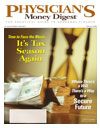Publication
Article
Physician's Money Digest
Achieve Optimal Capital Gains with an IRA
Author(s):
A variety of different investmentaccounts exist—brokerage-based, tax-deferred,or tax-free—and a physician-investor'schoice can make a world of differencein capital gains over a long periodof time. For optimal gains, the financierwho invests in stocks should employ asuccessful investment system thatworks for them regardless of its nature,whether it is technical (eg, trend-based),a growth investing system such asCANSLIM™, or any other thoroughand proven methodology.
While an investor can realize greatcapital gains through market trading,the income earned in a regular brokerageaccount is subject to taxes everyyear. But there are investment avenuesthat offer tax advantages. With a traditionalIRA, pretax contributions andinvestment earnings grow tax-deferreduntil you begin to make disbursements.The Roth IRA offers tax-free growth ofafter-tax contributions, while an educationsavings account, such as aCoverdell, also offers tax benefits forcollege savings. It is the savvy investorwho employs a variety of investingmethods, both brokerage-based andtax-advantaged, that realizes the greatestcapital gains over time.
Calculating Capital
Principles of Corporate Finance
Let's use a mathematical formula toshow the earnings of a successfulinvestor who uses a regular brokerageaccount. The calculations are adaptedfrom (McGraw-Hill; 2005) by Richard A.Brealey, Franklin Allen, and Stewart C.Myers. An investor's after-tax capitalgain is calculated as CxGx(1-T),where C is capital, G is percent gain,and T is the tax rate. Total after-taxcapital at the end of the first year isthen C+CxGx(1-T)=Cx(1+G(1-T)).Total after-tax capital at the end of Nyears is Cx(1+G(1-T))N.
For tax-deferred growth startingwith the same capital, the investor'scapital gain at the end of the first yearis CxG. Since taxes are deferred, thetotal capital gain at the end of the firstyear is C+CxG=Cx(1+G) and totalcapital at the end of N years isCx(1+G)N. Now assume that theinvestor withdraws all money from theaccount and pays taxes. Earnings atthe end of N years is Cx(1+G)N-C,which is approximately equal toCx(1+G)N. After-tax earnings at taxrate T is Cx((1+G)N-1)x(1-T), andtotal after-tax capital at the end of Nyears is C+Cx(1+G)Nx(1-T).
Brokerage Vs IRA
Now we'll plug in sample values.For simplicity, assume that the savvyinvestor starts with capital of $1 million,realizes a gain of 20% every yearin his trading account over 20 years,and the tax rate is 30%. If the investorfollows their chosen trading systemconsistently, the total after-tax capitalin a regular brokerage account at theend of 20 years using the formulaCx(1+G(1-T))N is:
$1 millionx(1+0.2(1-0.3))20=
$13.7 million.
On the other hand, if the investoremploys the same system with a tax-deferredaccount starting with thesame capital at the same tax rate, thetotal after-tax capital at the end of20 years using the formula C+Cx((1+G)N-1)x(1-T) is:
$1 million+$1 millionx
((1+0.2)20-1)x(1-0.3)=$27 million.
While real-world values and situationsmay differ, the point of this exerciseis to show how you can make aninvesting choice among differentaccounts using mathematical equationsand calculations. A savvy investorwho shows consistent growthof capital in a brokerage account bymastering the art of investing can realizeeven greater gains by employingtax-deferred investment vehicles. Withthe help of a tax consultant and financialplanner, physician-investors cancreate a retirement plan for optimalgrowth of capital.
is a private money manager
affiliated with Sierra Capital Planning in
northern California. He runs a fee-based
business and a hedge fund for qualified investors.
For more information, call 877-467-
8657 or visit www.sierrainvestor.com. Avinash Agrawal contributes
to stock research and wealth management at Sierra
Capital Planning Inc. Mr. Agrawal has master's degrees in
electrical engineering and in management science from
Stanford University, with an emphasis on pricing stocks and
derivatives. He has been interviewed by Investor's Business
Daily and has contributed articles to Working Money.
Michael Doran
